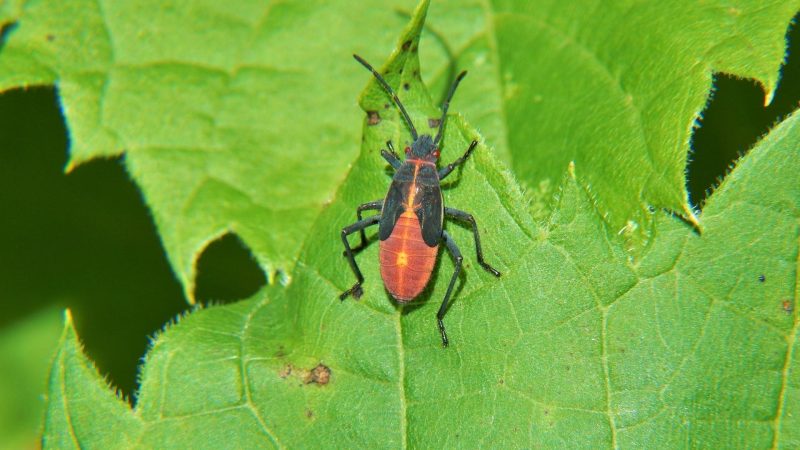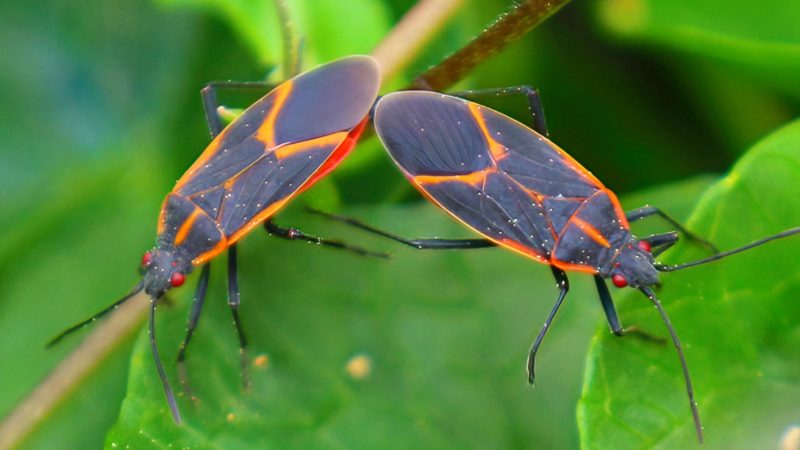Boxelder bugs don’t cause significant damage to plants and properties. They also don’t transmit diseases and rarely bite humans. But still, these insects are considered nuisance pests when indoors because they emit a very foul odor when crushed. No wonder that homeowners want to get rid of them.
But, how do you get rid of boxelder bugs? The best way to get rid of boxelder bugs is to remove their food source and block all their possible entries to your house. If they are already inside, sweep them outside or use a vacuum cleaner. Indoor insecticides may help but will not always work effectively.
Getting rid of boxelder bugs may look easy but can be very challenging. These annoying pests usually enter houses in multitudes. Also, insecticide treatment is not recommended and may not be 100% effective. But before taking any action, you should know them better, including their appearance and eating behaviors. Read on to learn more.
Table of Contents
What Are Boxelder Bugs?

Boxelder bugs are “true bugs” that belong to the Rhopalidae family, which ironically is also called “scentless plant bugs.” They are close relatives of Coreids, and both of them belong to the Order of insects known as the Hemiptera. Nevertheless, Coreids, such as squash bugs, have stronger smells than boxelder bugs.
Scientifically known as Boisea trivittata, boxelder bugs undergo incomplete metamorphosis. Therefore, they pass through three different life stages – egg, nymph, and adult. Females usually lay eggs in the spring, and the eggs will hatch within 1-2 weeks only. The nymphs will then grow into adults in the summer.
During the fall season, boxelder bugs start to invade homes as they search for warm places for preparation in winter. Nevertheless, you may also see them in all of their developmental stages during hot, dry summer. But once winter comes, adult boxelder bugs hibernate in cracks and crevices and walls as well.
What Do Boxelder Bugs Look Like?

Adult boxelder bugs are about 1/2 inch (12.7 mm.) long and 1/3 inch (8.46 mm.) wide. They have a pair of black wings that lay flat on their bodies when they are at rest. These wings overlap each other and somehow form the letter ‘X’. They’re frequently confused with other real bugs like squash bugs and leaf-footed bugs.
What Color Are Boxelder Bugs?
Adult boxelder bugs have a black body and orange or red abdomen. These pesky household pests have three longitudinal stripes on their prothorax (area behind their head).
Moreover, they have several fine red lines on both wing pads. They have 6 black legs and two antennae that are about half their body length.
What Do Young Boxelder Bugs Look Like?
Young or nymph boxelder bugs look like their adult version but are smaller. They are about 1/16 inch (1.6 mm.) long and are bright red when newly hatched.
But as they grow bigger and approach adulthood, they slowly change to black and red. Newly laid eggs are yellow but are becoming red as nymphs inside grow.
Where Did Boxelder Bugs Come From?

Boxelder bugs come from boxelder trees, hence their name. Their overwintered females lay eggs in the cracks and crevices of these trees. However, they may also live in maple and ash trees. These three trees are native to North America and are invasive species. No wonder that boxelder bugs are almost everywhere.
What Do Boxelder Bugs Eat?

Boxelder bugs eat by sucking saps of leaves, flowers, twigs, and developing seeds of boxelder trees. However, they have also been observed feeding on several fruits such as apples, cherries, grapes, and peaches. These sap-sucking insects punch holes on these fruits until they will become lumpy and deformed.
Do Boxelder Bugs Bite or Sting?
Generally speaking, boxelder bugs don’t bite. However, there could be some rare instances that they will, particularly when they are disturbed or threatened.
So far, there are no reports about boxelder bites are harmful. Boxelder bugs also don’t sting and have no venom or poison. Therefore, they are not dangerous.
Should I Worry About Boxelder Bugs?
You should worry about boxelder bugs, especially if there are lots of them swarming in your home. This is because their feces have a very strong foul odor that can leave stains on curtains, walls, and other surfaces. Another problem is that spraying insecticide indoors may not prevent them from emerging again.
Boxelder bugs may not be harmful pests, but they can be very annoying. In severe cases, hundreds of them may invade your home. It is also not advisable to crush them to death because of the horrible smell they release once they are alarmed. The only consolation is that boxelder bugs don’t reproduce indoors.
Why Are There Boxelder Bugs in My House?
Boxelder bugs are in your house because they seek warm shelter and their food source is likely to be near your place. These household pests entered your house through cracks and crevices, and other small spaces, especially if the weather starts to get cold. They are also very attracted to light-colored houses.
How to Trap Boxelder Bugs in House?
Prepare a white (or yellow) cardboard or plywood and cover one side with double-sided tape. Place the trap outside your house, near the areas that boxelder bugs are attracted to, such as warm spots. Once these pests are trapped, they can no longer escape. To avoid foul odor, dispose of the traps at once.
The more traps you make, the better. However, don’t expect them to get rid of boxelder bugs completely. These traps can reduce their numbers but only for a while. This is because there will be more of them entering your house instantly. Therefore, boxelder bug traps work but are not considered long-term solutions.
What Do Boxelder Bugs Hate?

There are claims on whether essential oils can repel boxelder bugs, but here are some of them that you may want to try at home:
- Basil
- Citrus
- Eucalyptus
- Lavender
- Lemongrass
- Rosemary
- Peppermint
- Tea tree
Aside from essential oils, boxelder bugs also hate the smell of some herbal plants. To make these plants effective, start planting them in window boxes in the fall. This is the season when these bugs are getting ready to visit your garden to find shelter against winter.
Here are some herbal plants you can try:
- Clove
- Lavender
- Sage
- Mums (Chrysanthemums)
You can also put these herbs in sachets and place them in areas where there is a huge presence of boxelder bugs.
How to Prevent Boxelder Bugs From Entering Home?
As mentioned earlier, boxelder bug infestation indoors can be very annoying and challenging. Therefore, you should prevent them from entering your home before it’s too late. Aside from placing traps around your house, here are some of the preventive measures that you should do and the things you should not do.
1. Block all their conceivable points of entry.
Seal all cracks and crevices, including those in phone lines, utility pipes, siding, attic, chimneys, etc. Repair or replace the damaged screen of doors, windows, soffit vents, and kitchen fans. Install a rubber seal at the bottom of your garage doors.
2. Remove boxelder trees.
Remove female seed-bearing boxelder trees within the area around your house. This is to eliminate their food source. Note, however, that they can fly up to 2 miles (3.2 kilometers) from one boxelder bug tree to another.
3. Eliminate their habitat.
Remove landscape mulch, piles of rocks, leaves, old boards, and debris such as wood chips, bricks, and gravel around your house. If you cannot remove the boxelder trees, clear the fallen seeds under and around them.
4. Spray pesticides.
Spray pesticides around the outside walls of your house, especially during the fall season. However, you should spray frequently because boxelder bugs will keep on coming even if you have already killed lots of them.
5. Don’t squeeze them.
As mentioned earlier, it’s not advisable to squeeze or crush them, especially with your bare hands. Otherwise, they will emit a very foul odor that could leave stains on hard surfaces such as walls, curtains, and furniture.
How to Get Rid of Boxelder Bugs Naturally?
To get rid of boxelder bugs naturally, you can do the following:
- Mix soap and water and spray directly on boxelder bugs that are on the outside wall of your house.
- You can also use pure water, as long as you spray it to them forcibly or wash the entire wall thoroughly.
- If boxelder bugs are already inside your house, sweep them out carefully. Otherwise, they will be startled and may release their very stinky odor.
- You can also use a vacuum cleaner. Just make sure you replace the vacuum bag so that none of them will be left behind.
How to Exterminate Boxelder Bugs?
Most pesticides can exterminate boxelder bugs effectively. However, some pesticide formulations contain harsh chemicals that can harm humans, pets, and plants. Besides, these stubborn pests will come back every fall season. This is why the other strategies mentioned above are also only temporary solutions.
Spraying insecticides indoors can also help eradicate boxelder bugs. However, you will need repeated applications because they attack houses in huge numbers. Aside from that, carpet beetles feed on dead boxelder bugs. This means that they are also very likely to cause infestation inside your house.
Do Boxelder Bugs Have a Purpose?
The only known purpose of boxelder bugs is to annoy humans by invading homes and releasing foul odor. These household pests don’t pose any health risks, and they don’t cause damage to plants and properties. Although these characteristics are somehow good, boxelder bugs are not beneficial insects.
Summary
Boxelder bugs are widely distributed mostly in the Eastern part of the United States, where there are lots of female boxelder trees. Unfortunately, there is no permanent solution to eradicate them. Therefore, the best way to control them is to prevent them from entering your home. If you can’t, simply sweep them out.